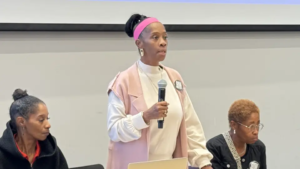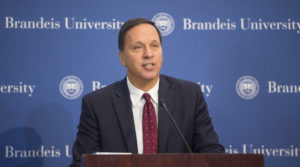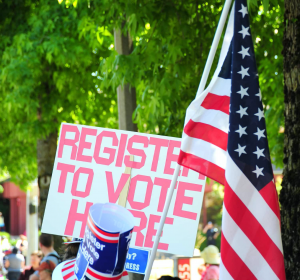In boxes and in hoodies, by bicycle and subway, New Yorkers are bringing injured birds to the city’s only wildlife rehab center.
When Genevieve Yue brought an injured pigeon to Manhattan’s Wild Bird Fund wildlife rehabilitation center last Saturday, she was surprised to find a line outside.
“A couple ahead of me had a bird in their sweatshirt. Other people had birds in Amazon boxes. Mine was in a take-out bag that I’d grabbed from a restaurant,” she says. One passerby asked if people were waiting in line for an ice cream shop.
Yue had found the injured pigeon lying on the sidewalk in her Lower East Side neighborhood and knew the bird needed help. “I have a particular fondness for pigeons. It breaks my heart when I see people treating them like vermin,” she says. She lined a paper bag with a spare diaper she had packed for her two-year-old, hopped in a Lyft, and headed north to the Wild Bird Fund on the Upper West Side.
It’s a tiny nonprofit operation tasked with serving all of New York City. “It’s kind of like a bird emergency room,” Yue says. “Our little ambulances are basically paper shopping bags and shoeboxes.” Everyone in line bonded over their tiny charges. “We started immediately sharing. ‘Where did your bird come from? Where did you find your bird? Do you want to see my bird?’”
She didn’t know at the time that New York was in the midst of a wave of bird collisions. Between Friday, October 2, and Saturday, October 3, the Wild Bird Fund took in a record 220 injured birds, three-quarters of which were migratory songbirds including northern parulas, common yellow-throats, and many warbler species,
The annual winter migration south for North American birds started a few weeks ago, and with migration comes collisions. New York City Audubon scientists estimate that up to 240,000 birds die annually from collisions in the city. Nationwide, the number is estimated to be a staggering one billion.
Migrating birds, says Rita McMahon, founder and executive director of the Wild Bird Fund, fly through New York (and Washington, D.C., Philadelphia, Boston, and many other major East Coast cities that comprise the Atlantic Flyway migration path) and collide with glass on buildings. Interior lights behind windows confuse night-migrating birds, disrupting their ability to navigate and drawing them towards the light. During the day, windows reflect trees and sky, creating an invisible obstacle. Navigating glass windows is a minefield for any bird, but most who crash are “first years,” says McMahon—they’re less than a year old and haven’t migrated through a city before.
Birds colliding with glass is not a new problem. Nor—despite the record numbers of birds brought into the Wild Bird Fund last weekend—is there any indication that it’s getting worse in New York. It’s not that more birds are crashing, McMahon says. It’s that more people are helping.
“More people seem to know about us. They come from great distances. Like from the edge of Brooklyn, or Rockaway Beach. It can take them two hours to get to us,” she says. “If you put a bird in your pocket or paper bag, you could be saving his life. Otherwise he will die of hypothermia on the sidewalk.”
Since April, the center has been taking in more injured animals than the same period last year. “I believe there is a silver lining to COVID. People are valuing nature more. They’re on the watch for things they haven’t noticed before. It’s very heartening and so reassuring to learn that New Yorkers are that compassionate,” she says.
A PARTICULARLY BAD WEEKEND
McMahon and her colleagues were expecting the birds. Staff and volunteers follow radar reports on birdcast.info, a website that shows incoming nocturnal bird migrations. Bird-watchers use it to track sighting opportunities; bird rescuers use it to track potential tragedy.
On the night of Thursday, October 1, the radar predicted a high-intensity migration over the entire country. Calista McRae, a volunteer who patrols for injured and dead birds most mornings throughout the year, prepared paper bags (for injured birds) and plastic gallon bags (for dead ones).
“When I got to the first building on Friday morning, there were 30 birds on one side, dead and alive.” She walked around the building and found another 40. She spent several hours on Friday and Saturday day collecting birds. In all, she collected 333 birds—231 dead birds and 102 injured ones, which went to the Wild Bird Fund.
“We knew there would be plenty but didn’t expect the onslaught,” McMahon says. Wild Bird Fund put out a call on Twitter, asking for volunteers to help transport birds to the facility. One couple loaded 50 into their car; a woman secured two onto her bike, while another brought four on the subway.
At Wild Bird Fund, staffers triaged the patients as they came in. Every bird is individually assessed, and the team separates them into categories based on the severity of their injuries. If a bird starts hopping around, it’ll get housed in the “flyway” room, where they can fly around, perch, and be monitored for 24 hours. Most birds, however, are kept in cloth laundry baskets, about six or eight per basket, where they have little perches. This weekend, McMahon says, they had 20 laundry baskets in a single room. Severely injured birds are kept in incubators in a quiet, intensive care unit-type room.
They’re all fed mealworms. The tinier, the better, so they don’t have to bang their possibly-concussed heads around trying to break a large bug apart. Last weekend, the center ran out, and volunteers scoured pet stores all over the city and rounded up three dozen mealworm tubs.
Of the 220 birds that came in, 90 died or were euthanized. More than a hundred recovered; many have already been released. When the birds are recovered, volunteers release them at Prospect Park and other locations in Brooklyn, where they’re able to fly due south—over the water and away from the city. “We don’t know what happens after, but if we can ensure that they don’t have to see any more buildings this year, we feel more secure that they’re going to do OK,” McMahon says.
COLLECTING DEAD BIRDS TO PREVENT MORE DEAD BIRDS
In December, the New York City Council passed a law that mandates any newly constructed building must be built with bird-safe glass. It’s a good step, McMahon says, but it doesn’t apply to existing buildings. There are several that are especially dangerous for birds, like 3 and 4 World Trade Center and, a block away, Brookfield Place. “It’s a mirrored canyon that is so inviting for birds flying through,” McMahon says.
Glass collision isn’t just a downtown issue: Nearly 45 percent of collisions happen at low-rise buildings, according to the New York City Audubon.
It’s easy and inexpensive to retrofit a building to be bird-safe, McMahon says. Although some inexpensive preventions like netting aren’t very aesthetically pleasing, other common strategies include window decals, UV window films (invisible to humans but obvious to many bird species); and even basic screens. At night, something as simple as turning off building lights that are visible from outside can be effective, according to the American Bird Conservancy. For new buildings, decisions about the type of window glass, the position and number of windows, and style of outdoor lighting can all make a difference.
Collecting data about bird crashes around a particular building and approaching management about mitigation are also important parts of the equation, McMahon says. It’s what motivates McRae to go out and collect dead bird bodies in the mornings, recording where and when she found them.
“If you can say to a building owner that your building killed 350 birds this fall between 6 to 9 a.m.—what can you do to prevent this?” it’s more likely to make an impact, she says.
Volunteering to count, collect, and rescue injured birds is a great way for people to feel empowered to help, especially during such turbulent times, McMahon says.
Yue, who rescued the pigeon, says she felt that sense of purpose. She says that she practices social distancing carefully, so it was nice to be in a public space without the pandemic being her primary focus. “It’s like we were all on a mission. Everyone was doing something kind,” she says.
After her pigeon was admitted, she cried behind her mask as she walked away. “It was a mix of feelings. I was moved to see this humane behavior—to see this man holding a little bird in his hands—but I also felt so anguished that there was so much hurt and suffering,” she says. “It was kind of a release. There’s so much hurt going around, but also so much caring.”
Yue’s pigeon turned out to have a broken back and had to be euthanized. Sometimes “stopping suffering is all we can do,” says McMahon, who personally cared for the bird. What Yue did, she says, “was not a small thing.”



